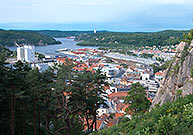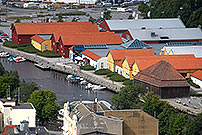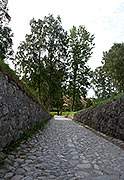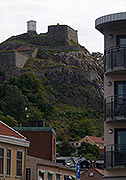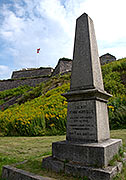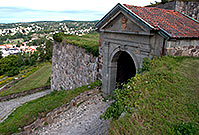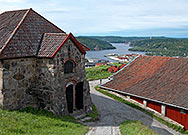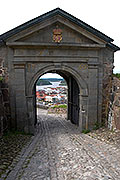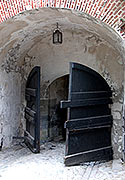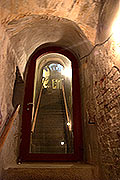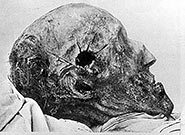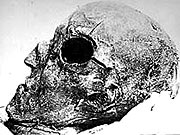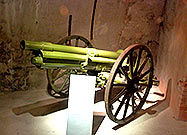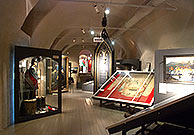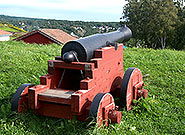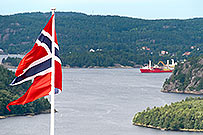Fredriksten - a fortress on the hill
The first fortifications in the border town of Halden appeared in 1643-45 and consists of a small artillery timber blockhouse on the site of the present Citadel and a wooden palisade to the south of it obstructing the valley road of the city.
In 1658, Northern Seven Years War between Sweden and Denmark-Norway ended with agreement in Roskild, according to whom greedy Sweden, among other things, acquired a Norwegian province of Bohus with big fortress with the same name. The new border passed along the river Tisra, on which the small town of Halden was. From 1658 to 1661 Halden three times was subjected to the Swedish invasions. It's fortifications were improved, new forts and palisades were built. In 1658 citizens and the surrounding peasants together defended their native land from 1500 Swedish troops from a nearby Bohuslёn. It became clear that the city had an important strategic position and the Danish King Frederick III ordered to build a powerful stone fortress here.
After half a year the Swedes attacked with renewed vigor, but Halden at that time had a small and bold garrison under the command of colonel Tonne Huitfeld, who repulsed Swede's assault.
In January 1660 Swedes had taken a big invasion to Christiania (Oslo) to finally conquer all the Norway. On the way of the invaders a new stone fortress of the five bastions was stand. By that time it was renamed as Fredriksten (and the city became known as Fredrikskhald), in honor of the Danish King Frederick III. Its fortifications were designed by Danish military engineer Villem Coucheron. The garrison of 2,100 people flatly refused to surrender the fortress the Swedes began the regular siege with furious assaults and bombing. Norwegians have withstand and late February Swedes hit the road. In February 1660, Charles X Gustav died and peace negotiations began again.
Taking advantage of peace time, Norwegians in 1673-75 years modernized their fortifications along the Swedish borders. It's current outline the Citadel got during this period. In 1673, the newly appointed Danish Governor-General Ulrik Frederik Gyldenløve inspected the Norwegian border fortifications. On his orders new fortifications were erected.
At the beginning of the so-called Gyldenløves war in 1675-79 Fredriksten fortress was used as the base for the operation of the Danish-Norwegian forces in Bohuslen. In 1676-77 4 thousand Norwegian troops under the command of General Russenstein took all Bohuslёn, captured an important fortress of Marstrand, and united with the Danish Army of General Lovenhjelm, hammered 8000 Swedish army of General de la Gardie.
Border was moved south, but Fredriksten continued to strengthen and improve. In 1682-1701 three forts on the commanding heights around the Citadel - Gyldenløve, Overberget and Stortarnet were built, as well as strengthening to the west of the Citadel - Borgerskansen or Citizen fortification.
In 1700 the Great Northern War began. Harsh time for Norwegians came in 1716. By that time, more than 5,000 of the best Norwegian troops were sent to fight on the continent. In March 1716, Charles XII invaded Norway and seized the capital Christiania, but failed to take the fortress Akerhus because lack of heavy artillery. It was not good for him to have the Fredriksten fortress with Norwegian troops in his rear and he decided at first to settle deal with a cheeky fortress.
July 4 of that year, the Swedes attacked Fredrikskhald all at once, but the townspeople lit their homes and retreated under the protection of the fortress. Swedes have no means for the long siege and had to get out.
Two years later, in the autumn of 1718 they came under the walls of the fortress again, armed with heavy artillery and everything necessary for a long siege. Garrison at that time was 1,400 desperate fighters who resisted fiercely and devotedly, nevertheless the beginning of December of the next year the Swedes managed to take Gyldenløve fort and began to dig trenches under the wall of the Citadel.
Late in the evening December 11, 1718, Karl XII, personally inspected siege works and was killed instantly by a bullet in the head. Unexpectedly for defenders of the fortress, Swedes lifted the siege and got out. There is debates about who killed Charles XII until now. The poor king had experienced four exhumation after his death, last one was in the 1900s (see photo).
It was established that he was shot in the head by a bullet caliber about 18 mm and such caliber new muskets shortly before were received for Swedish officers. However, the same caliber buckshot was used for its Norwegian artillery. Norwegians prised for this kill to themselves, but Swedes says: who knows, maybe it was some one from our ranks... That was very exhausting war. In any case, the monument to Charles XII in Stockholm is fenced with strong chain by Swedes so 'the damned king did not go again somewhere.'
During the Russian-Swedish War of 1788-90 fortress served as the operational base of the Danish-Norwegian troops during their attacks on the Swedes in Bohuslen. However, due to the intervention of Prussia and the United Kingdom, Denmark was forced to stop hostilities and declare neutrality.
During Napoleonic Wars in 1814, the fortress was attacked again by Swedes but withstood. New Swedish King Karl Johans (Bernadotte) instead of lost Finland,was promised Norway, which was taken from Denmark, ally of France. But Norwegians announced it's independence. Swedes invaded immediately and on his way to Christiania besieged Fredriksten. Norwegian garrison was held until the end of the war and lowered the flag only after the conclusion of a peace treaty, under which Norway entered into a union with Sweden.
In the 19th century. the fortress lost its military significance to a large extent, however, there continued to be a strong garrison, as surrounding Norwegian population was not happy about Swedish rule. At the end of the century new large-caliber guns were installed at the Citadel and in the outer fortifications.
After the break the union with Sweden fortress has to be completely disarmed in accord of the treaty, but it continued lodge Norwegian military for a long time. Military abandoned fortress in 2005, but College of military logistics and administration is here to this day.
Today Fredriksten fortress is open to visitors. There are several museums, it hosts the annual exhibition and a wide variety of events such as opera and song festivals, military-historical reenactments, etc. The public is looking forward to 2018, when it turns 300 years from the date of the last siege of the fortress. After large-scale restoration works at the end of the 2010s every summer evening fortress visitors can see free light show - light pictures of the history of the fortress walls on its bastions.
Impressions
Impressions are a very, very positive, as in general all in the Scandinavia, even in spite of the Norwegian weather. The fortress stands on the mountain and fantastic views of the city Halden and surrounding mountains, fjords, fields and pastures can be seen from it' bastions. Bastions of the fortress beautifully harmonize with high mountain ridge and dominates the town and peaceful Norwegian nature all around.
Land forts and fortress:
Bip Castle Gatchina Ivangorod Izborsk Kexholm Kirillov Monastery Koporye Novgorod Pechorskiy Monastery Peter&Paul Fortress Porkhov Pskov Schlisselburg Staraya Ladoga Tikhvin Vyborg Hameenlinna Hamina Kastelholm Kymenlinna Lappaenranta Raseborg Castle Savonlinna Tavetti Turku Visby Fredrikstadt Fredriksten Hegra Fort Hoytorp Fort Arensburg Narva Tallinn Antipatris Caesarea Jerusalem Latrun Fort Masada
Sea forts and fortresses:
Alexander Fort Ino Fort Krasnaya Gorka Fort Kronstadt: Kotlin isl. Kronstadt: North Forts Kronstadt: South Forts Trongsund Hanko Svartholm Sveaborg Marstrand Siaro Fort Vaxholm Oscarsborg
Artillery batteries and individual guns:
Coastal Artillery Hemso Fort
Fortified areas and defensive lines:
Karelian Fortified Area (KaUR) KrUR Leningrad Mannerheim Line Nevsky Bridgehead VT Line Harparskog Line Salpa Line Gothland
Russian
S e a r c h All news


